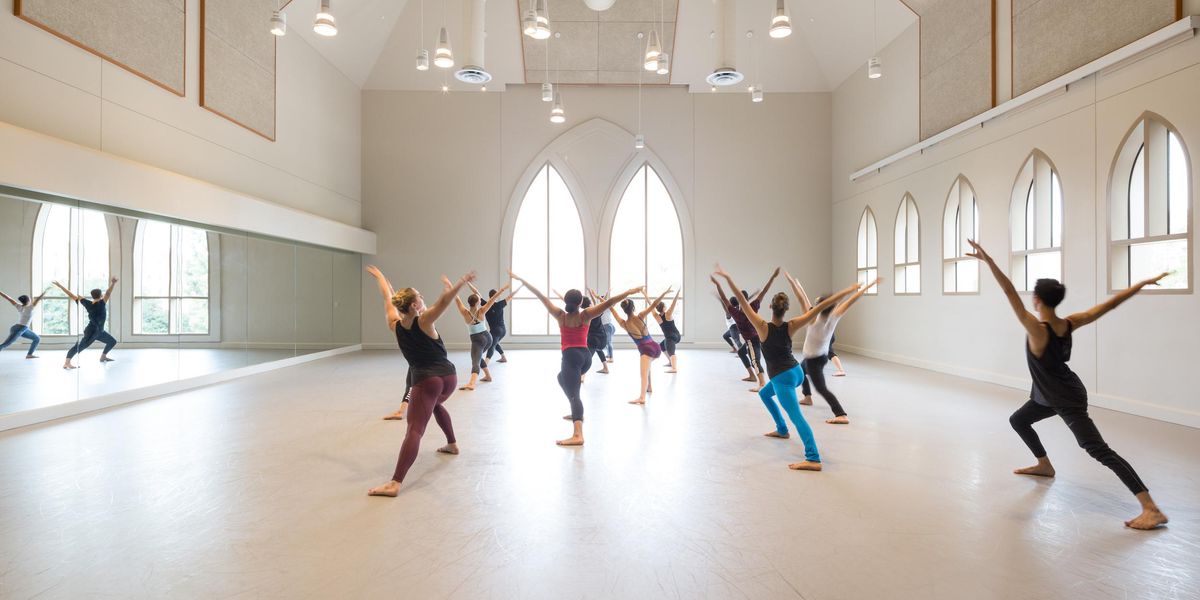On Broadway: Rent Redux
Keigwin with
Rent dancers. Photo by Matthew Murphy.
Off-Broadway theaters have a lot less room for dancing than the big Broadway houses. So it seems counterintuitive that a show would end up with additional choreography after leaving Broadway. But that, says Larry Keigwin, is what he’s hoping for when the megahit Rent, which closed at the 2,055-seat Nederlander about three years ago after more than 5,000 performances, returns this month to a 499-seat house at New World Stages.
It’s a revival, but don’t call it that. Michael Greif, who directed the 1996 original, said he’d return to the project only if he could bring in new collaborators to join the party. So Jonathan Larson’s Tony- and Pulitzer-winning rock treatment of La Bohème has a new set, new costumes, and a new choreographer in Keigwin. “I remember the first time I talked to the producer,” Keigwin says. “He’s like, ‘If you haven’t seen the show, that’s a good thing.’ They wanted new eyes on the creative team.”
Keigwin had seen the show, about a decade earlier, and noted that there wasn’t much of Marlies Yearby’s choreography. As rehearsals got underway, he was suggesting ideas which would engage the ensemble more in some of the numbers. “Not necessarily with dance steps,” he points out. “Hopefully, there’ll be more creative ways of moving people around the stage.” Mark Wendland’s set, he notes, resembles a jungle gym and offers myriad opportunities for innovative movement, some of which will be based on the drag competitions documented in the 1990 film Paris Is Burning.
Another source of inspiration for Keigwin is a quote from Larson, who died in 1996, the day before his masterwork gave its first public performance. “He had a dream of bringing the MTV generation to Broadway,” Keigwin says. “So I have been thinking of how to bring the MTV video aesthetic to some of the staging.”
He’s in a good position to do that. A self-proclaimed product of the ’80s, he says, “I feel connected to the source material a lot.” In fact, Keigwin began his professional career dancing on the cable television show Club MTV, with other teenagers who might well have come from the raw Lower East Side streets of Rent. “Full circle,” he says.
He’s come around to his roots in another way as well. He made his reputation as a dancer with contemporary choreographers like Doug Varone, Jane Comfort, Mark Dendy, and John Jasperse. As a choreographer he’s known for taking on diverse projects—making dances for the Rockettes, for 150 fashion models, and for his own troupe, Keigwin & Company, which he founded in 2003. By 2004, he had made Dance Magazine’s “25 to Watch” list. But his road to dance was paved with musical theater.
“My father had plenty of cast albums around, and I remember him renting all sorts of musicals on video,” the Long Island native recalls. “Then in fifth grade, I was cast as George M. Cohan in a little grade-school musical.” The teacher asked him if he could tap. He said yes. “Actually, I didn’t even have tap shoes,” he says. “I just made it up. From that moment on, I was always gravitating towards theater.”
In high school, someone who noticed him in the ensemble of My Fair Lady suggested he start taking dance classes, and the gravitational pull of theater soon gave way to a dance degree from Hofstra University. But musical theater, he says, “is still such a part of me.”
That part has been working overtime lately. It began in the spring at the American Conservatory Theater in San Francisco, with the world premiere production of Tales of the City, a new musical based on the novels of Armistead Maupin. Set in freewheeling 1970s San Francisco, the show has none of the dark edge of Rent.To make sure one show wouldn’t bleed into the other, Keigwin developed what he calls “a cheat sheet”—a list of adjectives defining the mood he was going for in each. The Tales list included words like bouncy, flirtatious, and episodic. “Rent,” he says, “is a little more gritty—angsty, youthful, passionate, hungry, sexy, athletic.”
Working on Tales, he says, was a learning experience that informed not just his subsequent work on Rent but also the approach he will take when he returns to working with his own company. “In theater the view is so 360-degrees—music, costumes, lights, sound design. The overall experience is so thought-out, detail-oriented. I’ll take that into the contemporary dance world.”
Keigwin says he didn’t mind being a newbie in musical theater. “Feeling like a student again was wonderful,” he says. “To learn something new and to expand my knowledge felt great.” Trading in his autonomy and his ability to call the shots was well worth it, he says. Besides, he hasn’t lost that can-do fifth-grade spirit: “I feel it would be really great to create my own musical and blaze my own path,” he says. And by then, he will have acquired the tap shoes.
Sylviane Gold writes on theater for
The New York Times.




